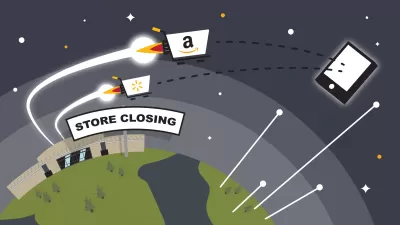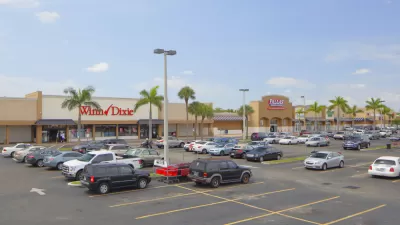The question of whether Amazon's ownership of Whole Foods will make opportunities, or take them away, is still up for debate.

The recent announcement of the Amazon takeover of Whole Foods dominated the recent news on retail in the grocery sector. Since it took over Whole Foods, Amazon has cut prices over 40 percent on many staple products while pledging to maintain the company’s focus on local and organic products, signaling that it is willing to lower Whole Foods prices to compete with Walmart. Even with these cuts, analysts expect that the company will need to make even deeper cuts if it intends to beat Walmart.
With the Amazon takeover of Whole Foods still unfolding, lessons from the evolution of Walmart are important for planners and policy makers to consider. While the future of the company may not be in complete jeopardy as a result of the Amazon-Whole Foods merger, bigger problems for communities may come with changes to the industry. Recent work [pdf] shows that, increasingly, competition from e-commerce is likely lead to loss of local retail and stores, and ultimately a loss of taxable income, fresh affordable food, and jobs.
Although the decline of brick-and-mortar retailers has been steady, the evolution of Walmart into an e-commerce power provides a tangible example. Not only has Walmart forced many local closures, but they have also pulled out of many markets, leaving economic wounds—operating as both an "opportunity maker" and an "opportunity taker."
Walmart as Opportunity Maker and Taker
In early January 2016, Walmart announced a large reduction of stores worldwide, though a majority of closures will be felt at home in the United States. The multi-national retailer had brought hundreds of jobs to communities, but chose to end their Walmart Express venture—the company's foray into a small-store format aimed to compete with dollar stores. It also served as a failed attempt for Walmart to establish a larger market within urban centers and to invest in other aspects of the physical retail industry. The total number of closures was enormous: 102 Walmart Expresses, 115 Walmart stores, and 12 Supercenters.
There are a number of disconcerting aspects about these closures. The first revolves around the communities they impact. A total of 96 Walmart stores closed in areas categorized as low density and lower income. That figure is greater than the number of closures in the three other areas combined (high density, lower income: 25 stores closing; low density, higher income: 15 stores closing; high density, higher income: 18 stores closing). The closures proved worrying for these communities, especially where the initial introduction of Walmart Express stores pressured on or displaced local, small businesses. Many argued that the store closures disproportionately affected low-income and low-density areas, affecting those communities more dramatically and reducing access to service.
Larger communities have not been immune to the effects of the Walmart closures either. In larger communities, Walmart stores provide a sizable source of jobs and taxable income and serve important roles in the constitution of communities. Their loss poses significant challenges in finding suitable development opportunities that fit with a community's development goals and planning direction. The problem is in how to find a development solution in time to mitigate the potential economic effect—specific to the size of the community and in a way consistent with the community's values and vision.
Secondly, the closures represent a restructuring of how Walmart does business. Their failed experiment with Walmart Express highlights the problem the company has with any physical retail venture. Recently, Walmart partnered with August Home to make "in-fridge delivery" a reality. Most of Walmart's future ventures and investments will try to increase its competitiveness in the e-commerce space. Online sales across the company increased 73 percent year over year in the second quarter of 2017.
The Challenges of Turning Taker to Maker
The departure of Walmart, the idea of the company as a "taker," highlights the key challenge to the retail environment, both present and future, represented by e-commerce. The World Economic Forum projects that 15 percent of traditional retail stores will close over the next decade due to e-commerce. In this development vacuum, closures beget challenges but also opportunity—new opportunities to “make”. Cities where these properties sit vacant face a unique problem. The negative effect of the Walmart closures is compounded by the time required to find and locate developers. Both malls and big boxes can be difficult to refill with tenants. Many times communities are left with empty buildings for years.
A sample of 12 Walmarts that closed across the country exemplifies this difficulty. A year after the closures, many (almost half) still have not found tenants or developers for the former Walmart sites. Many communities are desperate for the jobs these retail establishments created, but also find the size that made the buildings such an attractive investment to Walmart in the past to be an incredible hurdle to overcome.
|
Store Location |
Year Open |
Date Closed |
City |
No. Employed |
Nearest Wal-Mart |
Development Status |
|---|---|---|---|---|---|---|
|
Juneau, AK |
2007 |
2/5/16 |
32,660 |
168 |
Ketchikan, AK (300 mi away) |
Still Seeking Development |
|
Fairfield, AL |
2006 |
1/28/16 |
10,952 |
~300 |
Hueytown, AL (3.7 mi away) |
Sale Pending |
|
Hartland, MI |
2009 |
1/28/16 |
14,663 |
~300 |
Howell, MI (7.8 mi away) |
Sale Pending |
|
Durham, NC |
2011 |
1/28/16 |
245,475 |
~200 |
Durham, NC (3.7 mi away) |
Sale Pending |
|
Las Vegas, NV |
2011 |
1/28/16 |
603,488 |
~350 |
North Las Vegas, NV (3.5 mi away) |
Still Seeking Development |
|
Bedford, OH |
2009 |
1/28/16 |
12,875 |
~350 |
Macedonia, OH (6 mi away) |
Still Seeking Development |
|
Winnsboro, SC |
1998 |
1/28/16 |
3,422 |
~300 |
Columbia, SC (18 mi away) |
Still Seeking Development |
|
Raymondville, TX |
2005 |
1/28/16 |
11,153 |
~150 |
Elsa, TX (18.6 mi away) |
Sale Pending |
|
Brownsville, TX |
2004 |
1/28/16 |
181,860 |
Data not found |
Brownsville, TX (2.1 mi away) |
Sale Pending |
|
Austin, TX |
Data not found |
1/28/16 |
885,400 |
Data not found |
Austin, TX (3.3 mi away) |
Sale Pending |
|
Houston, TX |
2007 |
1/28/16 |
2,196,000 |
Data not found |
Houston, TX (2.1 mi away) |
Still Seeking Development |
|
Kimball, WV |
2005 |
1/28/16 |
183 |
~300 |
Bluefield, WV (19 mi away) |
Sale Pending |
Lessons for Amazon and Whole Foods, and Lessons for Communities
So where does this does this lead? Perhaps Amazon and Whole Foods can be a part of the solution, creating new jobs, making opportunity, and filling some of the markets Walmart has left. Yet this also can be a challenge in attracting the company into appropriate space in a timely manner. In many communities, the real estate and economic development dialogue does not extend beyond the traditional real estate tools—for example, broker tours, breakfasts, and day-old doughnuts.
This presents an opportunity have a wider conversation about development. For example, in Cleveland, Ohio, a 66,000 square foot Big Lots closed, investors produced an $11 million investment to recreate a facility as the Collinwood Recreation Center. The idea of expanding the dialogue about what kind of development the community wants in a certain location, using tools like OppSites or the now defunct Opportunity Space to make development like that happen, is sometimes foreign to city leaders. That said, it is imperative that cities become more nimble and open to these kind of ideas—not only to seize opportunities from companies like Amazon but to be more resilient when they made decisions to take their business elsewhere.
In this light, we offer a challenge to local planners, community development officials, and civic leaders. We challenge them to tell the world what kind of development they want to see. In situations like the Walmart closures, large book or record stores like Borders and Tower Records, or even places like Toys "R" Us, which recently filed for bankruptcy, local knowledge can be an asset to outside developers unsure if they want to invest in a property.
We challenge civic leaders to tell the world why their community is awesome and why companies like Amazon, Costco, or Home Depot should consider a former Walmart location. The only way to buffer local communities from the decisions of multi-national companies that take jobs and economic growth away is to tell a local story on a national or even global level. We challenge cities to be empowered and tell it—learn from the lessons of Walmart and energize development in their communities.
Justin Jiang an urban data manager and designer at OppSites.com. Growing up in suburban Southern California, Justin was inspired by towns, cities, and built environments and their impacts on the world. He went on to receive a BA in Sustainable Environmental Design at the University of California, Berkeley, furthering his passion for built and natural environments.
William (Billy) Riggs, PhD, AICP, LEED APis an Assistant Professor in the School of Management at University of San Francisco. He is a thought leader in the areas of transportation, real estate, economics and technology, having worked as a practicing planner and published widely in these areas. He is also the principal author of Planetizen's Planning Web Technology Benchmarking Project, the co-creator of the ReStreet app, and author of a forthcoming book on re-envisioning future streets. He can be found on Twitter @billyriggs.

Alabama: Trump Terminates Settlements for Black Communities Harmed By Raw Sewage
Trump deemed the landmark civil rights agreement “illegal DEI and environmental justice policy.”

Planetizen Federal Action Tracker
A weekly monitor of how Trump’s orders and actions are impacting planners and planning in America.

Why Should We Subsidize Public Transportation?
Many public transit agencies face financial stress due to rising costs, declining fare revenue, and declining subsidies. Transit advocates must provide a strong business case for increasing public transit funding.

Understanding Road Diets
An explainer from Momentum highlights the advantages of reducing vehicle lanes in favor of more bike, transit, and pedestrian infrastructure.

New California Law Regulates Warehouse Pollution
A new law tightens building and emissions regulations for large distribution warehouses to mitigate air pollution and traffic in surrounding communities.

Phoenix Announces Opening Date for Light Rail Extension
The South Central extension will connect South Phoenix to downtown and other major hubs starting on June 7.
Urban Design for Planners 1: Software Tools
This six-course series explores essential urban design concepts using open source software and equips planners with the tools they need to participate fully in the urban design process.
Planning for Universal Design
Learn the tools for implementing Universal Design in planning regulations.
Caltrans
Smith Gee Studio
Institute for Housing and Urban Development Studies (IHS)
City of Grandview
Harvard GSD Executive Education
Toledo-Lucas County Plan Commissions
Salt Lake City
NYU Wagner Graduate School of Public Service





























